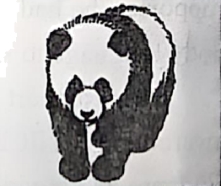
(2025届辽宁省丹东市高三下学期总复习质量测试(二)英语试题)The giant panda, once on the brink of extinction, has become not only a global conservation success story but also a powerful symbol of China’s cultural diplomacy (外交). Through decades of effort, China has transformed this black-and-white bear into a tool of “soft power” that bridges nations and shapes international image.

In the 1980s, wild pandas numbered fewer than 1,200 due to habitat loss and poaching. However, China’s strict protection laws and breeding programs have raised the population to over 1,800 today. This achievement caught global attention. To link the animal to worldwide efforts to protect environment, the World Wildlife Fund (WWF) adopted the panda as its logo.
But pandas do more than promote conservation. Since the 1950s, China has gifted or loaned pandas to foreign zoos as a diplomatic gesture, a practice called “panda diplomacy.” For example, in 1972, two pandas were sent to the U.S. after President Nixon’s historic visit to China, symbolizing friendship during the Cold War. Today, pandas are only loaned through scientific cooperation agreements, often tied to joint research on wildlife protection.
Pandas’ cultural impact is undeniable. Social media platforms show millions of videos of pandas playing, eating bamboo, or interacting with caretakers. Live-streaming from foreign zoos helps increase visitors and income. A 2022 survey by the BBC found that 68% of foreigners associate pandas with positive feelings toward China.
Moreover, China uses panda imagery in global events. Bing Dwen Dwen, the panda mascot of the 2022 Winter Olympics, became a hot product. Chinese movies like Kung Fu Panda (though made by Hollywood) further boosted its cultural influence.
Despite their success, critics argue that focusing on pandas may draw attention away from other endangered species. Others question if the “cute image” oversimplifies China’s complex environmental policies. Still, the panda remains a unique bridge between ecology and diplomacy.
54.What do the underlined words “soft power” in paragraph 1 probably refer to?
A.Cultural diplomacy. B.Scientific cooperation.
C.Animal conservation. D.Technological strength.
55.Why did WWF select the panda as its logo?
A.To conduct protection laws. B.To represent endangered animals.
C.To further science research. D.To symbolize conservation efforts.
56.How has “panda diplomacy” evolved since the 1950s?
A.From the U. S. to other countries.
B.From foreign zoos to global events.
C.From presents to scientific partnerships.
D.From living streaming to making movies.
57.What is a concern regarding panda diplomacy?
A.Pandas are difficult to breed in zoos.
B.Other endangered animals may be ignored.
C.Foreign zoos use pandas to earn money.
D.Environmental policies may be complicated.
【答案】54.A 55.D 56.C 57.B
【知识点】动物、说明文
该题有详细解析可以查阅1、本网站所提供的信息,只供教育教学参考之用。
2、本网站及其会员一概毋须以任何方式就任何信息传递或传送的失误、不准确或错误对用户或任何其他人士负任何直接或间接的责任。
3、在法律允许的范围内,本网站在此声明,不承担用户或任何人士就使用或未能使用本网站所提供的信息或任何链接或项目所引致的任何直接、间接、附带、从属、特殊、惩罚性或惩戒性的损害赔偿。
4、访问者在从事与本网站相关的所有行为(包括但不限于访问浏览、利用、转载、宣传介绍)时,必须以善意且谨慎的态度行事;访问者不得故意或者过失的损害本网站的各类合法权益,不得利用本网站以任何方式直接或者间接的从事违反中华人民共和国法律、国际公约以及社会公德的行为。对于访问者利用本网站提供的信息而作出的任何决策、决定以及其后果,本网站不承担任何责任
5、本网站图片,文字之类版权,本网站无法鉴别所上传图片或文字的知识版权,如果侵犯,请及时通知我们,本网站将在第一时间及时删除。
6、凡以任何方式登录本网站或直接、间接使用本网站资料者,视为自愿接受本网站声明的约束。
XueXi Design
